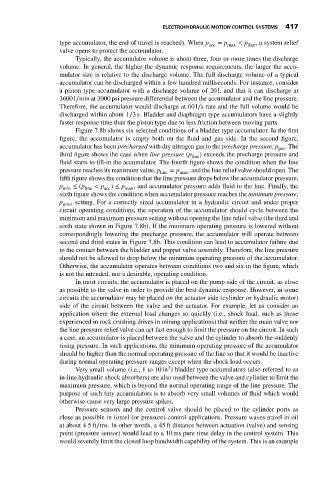Page 431 - Mechatronics with Experiments
P. 431
October 9, 2014 8:41 254mm×178mm
Printer: Yet to Come
JWST499-c07
JWST499-Cetinkunt
ELECTROHYDRAULIC MOTION CONTROL SYSTEMS 417
type accumulator, the end of travel is reached). When p acc = p max < p line , a system relief
valve opens to protect the accumulator.
Typically, the accumulator volume is about three, four or more times the discharge
volume. In general, the higher the dynamic response requirements, the larger the accu-
mulator size is relative to the discharge volume. The full discharge volume of a typical
accumulator can be discharged within a few hundred milliseconds. For instance, consider
a piston type accumulator with a discharge volume of 20 l, and that it can discharge at
3600 l∕min at 3000 psi pressure differential between the accumulator and the line pressure.
Therefore, the accumulator would discharge at 60 l∕s rate and the full volume would be
discharged within about 1∕3 s. Bladder and diaphragm type accumulators have a slightly
faster response time than the piston type due to less friction between moving parts.
Figure 7.8b shows six selected conditions of a bladder type accumulator. In the first
figure, the accumulator is empty both on the fluid and gas side. In the second figure,
accumulator has been precharged with dry nitrogen gas to the precharge pressure, p pre .The
third figure shows the case when line pressure (p line ) exceeds the precharge pressure and
fluid starts to fill-in the accumulator. The fourth figure shows the condition when the line
pressure reaches its maximum value, p = p , and the line relief valve should open. The
line max
fifth figure shows the condition that the line pressure drops below the accumulator pressure,
p ≤ (p < p ) ≤ p , and accumulator pressure adds fluid to the line. Finally, the
min line acc max
sixth figure shows the condition when accumulator pressure reaches the minimum pressure,
p , setting. For a correctly sized accumulator in a hydraulic circuit and under proper
min
circuit operating conditions, the operation of the accumulator should cycle between the
minimum and maximum pressure setting without opening the line relief valve (the third and
sixth state shown in Figure 7.8b). If the minimum operating pressure is lowered without
correspondingly lowering the precharge pressure, the accumulator will operate between
second and third states in Figure 7.8b. This condition can lead to accumulator failure due
to the contact between the bladder and poppet valve assembly. Therefore, the line pressure
should not be allowed to drop below the minimum operating pressure of the accumulator.
Otherwise, the accumulator operates between conditions two and six in the figure, which
is not the intended, nor a desirable, operating condition.
In most circuits, the accumulator is placed on the pump side of the circuit, as close
as possible to the valve in order to provide the best dynamic response. However, in some
circuits the accumulator may be placed on the actuator side (cylinder or hydraulic motor)
side of the circuit between the valve and the actuator. For example, let us consider an
application where the external load changes so quickly (i.e., shock load, such as those
experienced in rock crushing drives in mining applications) that neither the main valve nor
the line pressure relief valve can act fast enough to limit the pressure on the circuit. In such
a case, an accumulator is placed between the valve and the cylinder to absorb the suddenly
rising pressure. In such applications, the minimum operating pressure of the accumulator
should be higher than the normal operating pressure of the line so that it would be inactive
during normal operating pressure ranges except when the shock load occurs.
3
Very small volume (i.e., 1 to 10 in ) bladder type accumulators (also referred to as
in-line hydraulic shock absorbers) are also used between the valve and cylinder to limit the
maximum pressure, which is beyond the normal operating range of the line pressure. The
purpose of such tiny accumulators is to absorb very small volumes of fluid which would
otherwise cause very large pressure spikes.
Pressure sensors and the control valve should be placed to the cylinder ports as
close as possible in forcel (or pressure) control applications. Pressure waves travel in oil
at about 4.5ft∕ms. In other words, a 45 ft distance between actuation (valve) and sensing
point (pressure sensor) would lead to a 10 ms pure time delay in the control system. This
would severely limit the closed loop bandwidth capability of the system. This is an example

